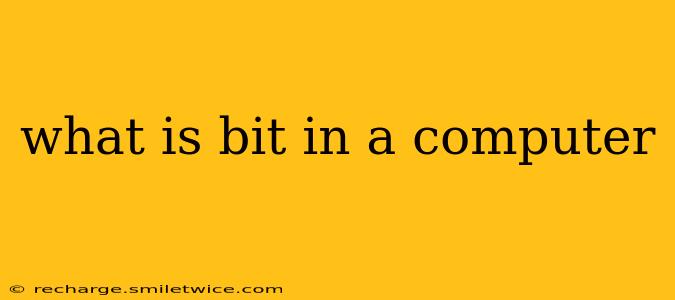In the digital world, everything boils down to one fundamental unit: the bit. Understanding what a bit is crucial to grasping how computers, smartphones, and all digital devices function. This comprehensive guide will explain bits, their significance, and answer some frequently asked questions.
What is a Bit?
A bit, short for "binary digit," is the smallest unit of data in a computer. It represents a single binary value, either a 0 or a 1. Think of it as a light switch: it can be either ON (1) or OFF (0). These seemingly simple 0s and 1s are the building blocks of all digital information, from text and images to videos and software programs.
How are Bits Used?
Bits themselves don't convey much meaning individually. Their power lies in their combination. Multiple bits are grouped together to represent more complex information. For instance:
- Byte: Eight bits grouped together form a byte. A byte can represent a single character (a letter, number, or symbol) in many character encoding schemes like ASCII or Unicode.
- Kilobyte (KB), Megabyte (MB), Gigabyte (GB), Terabyte (TB), etc.: These are multiples of bytes, used to measure larger amounts of data storage or memory. Each unit represents a progressively larger amount of data. (1 KB = 1024 bytes, 1 MB = 1024 KB, and so on).
Why Use Binary (0s and 1s)?
Computers use binary because it's the most efficient and reliable system for representing information electronically. Electrical circuits can easily represent two states: high voltage (1) and low voltage (0). This simplicity makes it possible to build incredibly complex and powerful systems using only these two states.
What is the difference between a bit and a byte?
The core difference is the quantity of information. A bit is a single binary digit (0 or 1), while a byte is a group of eight bits. A byte can represent a much wider range of data than a single bit.
How many bits are in a Gigabyte?
A gigabyte (GB) contains 1,073,741,824 bits (1024 MB * 1024 KB * 8 bits).
Can bits be physically seen?
No, bits themselves aren't physically visible. They represent electrical states within a computer's circuits. You can't see a single bit, but you can see the effects of billions of bits working together to display images, run programs, or store data.
How are bits related to data storage?
The amount of data a storage device (like a hard drive or SSD) can hold is directly related to the number of bits it can store. The higher the storage capacity, the more bits it can hold, meaning it can store larger amounts of information.
Conclusion
The bit, though seemingly insignificant on its own, is the bedrock of the digital world. Its simplicity and efficiency have enabled the creation of the powerful and versatile computing technologies we rely on every day. Understanding bits and how they are combined to represent information provides a foundational understanding of computer science and digital technologies.
